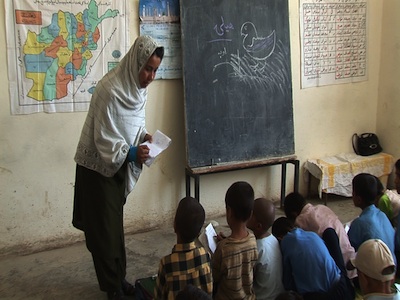
Reproduced with permission from The Christian Science Monitor.
Qala-e-Zaman Khan High School is bordered by dirt roads at the base of a small hill in one of Kabul's many districts. The school's mud brick buildings have been recently painted, and its bright blue walls, nestled against the drab hillside, stand out from a distance. "All the faculty pooled money to buy the paint," says principal Abdullah Amin, "and our families helped with the work."
But the paint is just one step along a very long road, he notes. "Our biggest problem," he says, "is that we don't have adequate classroom space for the high number of students."
Under the Taliban, Afghanistan had only 900,000 students, all boys. The curriculum revolved around religious instruction. Today, some 6 million students, boys and girls, attend schools – though some 5.3 million children wait in the wings, held back by cultural or security reasons.
But the momentum poses a huge challenge to a country pummeled by war and fraud-ridden elections. The rapid rise in enrollment has led to two pressing problems: a lack of professional teachers and too few schools and classrooms.
At Qala-e-Zaman Khan High School, those problems are clearly on display. The school has 4,000 students, but only 26 classrooms. A small house two blocks away has been rented, but has done little to ease overcrowding.
Ghulam, a teacher in Kabul for the past three years, says the problem is endemic. "According to guidelines, we should have no more than 40 students in a class," Ghulam says. "But as it is, we have a minimum of 50 to 60, and often 80 or more. This creates a lot of problems for the teacher, and as a result the quality of instruction goes down."
And, says Asif Nang, 75 percent of teachers hold only a high school diploma. "The greatest challenge facing the Ministry of Education is the lack of professional teachers," says Mr. Nang, a ministry spokesman. Poor pay and better opportunities for college graduates are factors.
"I would like to teach," says Aziza Kakar, a senior at Kabul's Education University. "But the salary just isn't enough, so I will try ... for an NGO [nongovernmental organization]."
Merit pay on the way
Teachers make between $50 and $100 a month. A US government official in Kabul says USAID is supporting a pay increase within the Ministry of Education that would raise the pay of Grade 12 qualified teachers from $96 a month to $130 – a figure still not competitive with the private sector.
But a recent exam given to teachers with at least two years of education beyond high school may help close the gap. Nationally, 42,000 teachers sat for the test of general knowledge, expertise in specialized subject matter, and methodology. Teachers who did well could eventually see a merit pay increase that would raise their salary to as high as $428 a month. But the increase will depend on money from foreign donors, according to the ministry.
Then there's the need for space: About half of Afghanistan's 12,000 schools have no permanent structure, with classes held in tents or in the open air, according to Nang.
The ministry and foreign donors built 1,500 schools last year, and plan to construct a similar number each year for the next decade. But that will not immediately alleviate overcrowding.
Backpack with just a pen and pencil
Despite the obstacles, many students go to great lengths to pursue their studies, some walking miles to attend, and others attending despite threats of physical violence from the Taliban and their sympathizers.
Nassar is a fourth-year student at Qala-e-Zaman Khan High School. He attends school from 1 p.m. until 4:30 p.m.; students are limited to a half-day because of overcrowding. But Nassar also works full time. "My dad has shrapnel in his legs from the war, so he can't work," he says. "My brother lost a leg. I work and give the money to my family for food."
On this morning, the day is already hot as Nassar pushes his wheelbarrow along a dirt road. He is hauling water to local homes.
He stops in front of two rusted Soviet tanks to catch his breath. Though only 12, he works from 5 a.m. to noon. Most days he delivers water, but he also works as a bricklayer. "I learned to lay bricks when I was 8, but I can't find work all the time," he says. He makes an average of $1.20 per day.
Nassar arrives at school with a backpack, but no books or paper – only a pencil and pen. In his class in the small house, 40 boys sit on the floor listening to a student read. Though he has worked seven hours, he is alert. "I hope to go through 12th year, and to university," he says. "I want to be someone someday."


